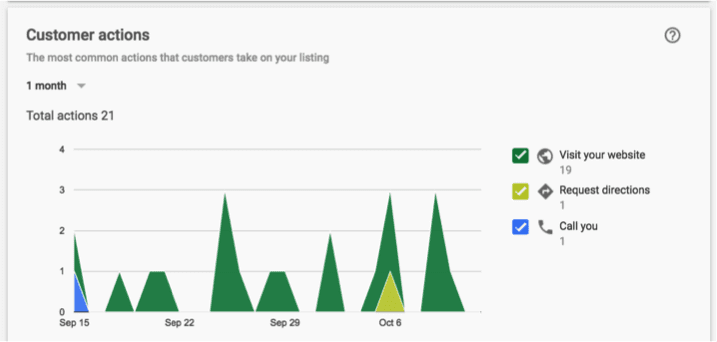Google has always supported local business to drive sales from search, non-more so than the Hummingbird algorithm change. The change brought about the ability for local business to compete in local search against their national competitors, complementing the already existing Google Local Carousel, or “map pack” as it is know.
Google My Business and The Google Local Carousel
Within local search there are three elements; paid search, the local carousel map pack and the main search engine results.
Competition for rankings on the local carousel – the maps section that used to rank up to 7 companies, but was cut to just 3 in 2016 – has often been speculated as a good source of leads and somewhere all companies should try and rank for. Why? Well up to 32% of users click a result on the local carousel, way more than paid search which gets a 6% click through rate from search, and its free to get through Google My Business, so who wouldn’t want to miss out on 32% of the traffic as part of their local search strategy?
Whilst there is still a little bit of mystery as to how you get your business to appear on the top 3 of the local carousel on Google search, is it any good for driving sales leads? Sure it can drive up to 32% of clicks from search, but is that tangible as a sale? We recently had a client who’s Google My Business entry was closed by the previous owner of the business, so didn’t appear on the Google results until we re-verified the business for the owner. However, their previous Google My Business entery was four years old and used to rank well, so if re-verified it would probably go back to its original rankings within the top three and make an ideal case study to track the leads generated from the Google Local Carousel.
Our analytics tool generates, tracks and analyses all leads from both natural search and paid search, whether on the phone or online, enabling any impact to be tracked and measured through a “before and after” a/b split test analysis of a verified Google My Business listing. The client in question was ideal, as it was one location which was pretty isolated.
We verified the listing on the 10th September and watched with intrigue as to the results.
Rankings on the local carousel improved, but they only got one call in 4 weeks
Prior to the Google My Business being verified in week 2 of September, our client did not appear in any non-brand searches within the local carousel and had limited information displayed when brand terms were searched.
As soon as the Google My Business entry was verified, within 2 hours, our client appeared in the local carousel in position 2 and 3 on both mobile and desktop for their top two non-brand search terms. As you’d expect, for brand terms, the client was positioned number one, with full contact details including their phone number. As the Google My Business entry was four years old but had been marked as ‘permanently closed’ by the previous owner, sending it back live gave an immediate impact in listing on the local carousel. You wouldn’t expect this from a brand new entry, so we were pretty lucky to get what we did from the local carousel listings. However, this gave us an exact before and after yard-stick to measure.
However, on review of the Google My Business Console on the newly created insights tab, only one call resulted from 576 views over the following four weeks, but they gained 19 visitors who clicked through to their website – arguably a source of visitors they wouldn’t have got without the Google My Business listing.


A 20% Uplift in Leads, But Did It Come From Google My Business?
To truly understand the impact of Google My Business, we then reviewed the lead volume, before and after the change on Google My Business, to understand the impact of the extra 19 visitors over the 4 weeks after we’d got the listing verified.


As the chart above shows, from September week 2, lead volume from natural search increased by 20%, with relatively little impact on paid search. But where did the uplift come from? Could it have been the extra traffic we’d got from Google My Business?
Although the pages for our client had a visitor to lead conversion of 12% for natural search and 48% for paid search traffic during the period, this wouldn’t equate to 20% uplift; at best the maths calculates 2.2 leads would have been generated from the 19 visitors from Google My Business using the natrual search conversion metric. During the period after the verification, the additional traffic would only have generated a 2% uplift, so where did the rest come from?
Natural Search Rankings Boost
During the same period in September, there was a significant Google algorithm update which affected natural search traffic substantially.
Dubbed the ‘Hawk’ by Search Engine land, the new algorithm change was a strictly local search change and saw our client significantly increase their local search rankings from the 1st Week September, with a spike of 14% in traffic from natural search as a result of the increase in rankings for the clients location pages.
The site performance in the specific location we were measuing saw a rise in non-brand search rankings of 2, meaning the client was now rankings in 5 of its top 5 keywords in position 4 or better for natural search. This gave the 18% increase in leads, with 2% attributed to Google My Business.
Traffic Analysis – Natural Search is Still The Daddy
To confirm this, we then compared the 19 visits we got from Google My Business to the natural search traffic we got for the same location page. Natural search traffic was eight times greater during this period, confirming why natural search is still by far the biggest generator of leads when compared to Google My Business and the Local Carousel. It might get up to 32% of the clicks, but they don’t necesarily turn into leads or sales.
But what of the one call they did have?
The one call that was created from Google My Business during the period after verification came from a brand search and was an existing customer looking to book another job.
As eSales Hub Analytics tracks the customers call, and even produces a call recording, it was very easy to understand that it was a returning customer. Happily that customer did book a new job for £190.
Google My Business is a Great Retention Tool, But Non-Brand Natural Search Generates 38 Times More Sales Leads.
At the start of this test, we had no idea what the results would show. My belief was that with around 30% of clicks coming from the local carousel, it had to drive leads, but it turned out not to be the case. This really surprised me as on mobile, the local carousel is the first thing you see, but evidently users do scroll past it.
But then again, think about it – on mobile, Google only gives you the ability to call a local company from the carousel. Who’d call someone they didn’t know for a local service without checking the companies website or even their customer reviews. As we mentioned in a previous blog about how different local search user behave, 88% of user check a companies reviews first before transacting. With this in mind, could Google improve lead conversion from Google My Buiness by providing a link to the company site rather than a call button? Could review stars be included, but not just from Google Reviews in the carousel.
What the numbers do confirm is that ranking for local search within the main results is even more important – you might focus on ranking in the local carousel, but you’d be missing out on almost 95% of sales leads if you are not in the local search results on Google.
Do you have more questions?
My goal in writing this article was to have a resource to point people to when wanted more information on how Google My Business and the Google Local Search Carousel performed as a lead generation tool. In talking to companies, large and small, I realised that many people understand the carousel and put a great deal of importance behind it, sometime to the detriment of the rest of the local search strategy.
Do you have more questions about local search? If so, I’d be happy to address them in the comments. I also would love for those of you who are experienced with dealing with Google My Business and Google Local caoursel strategies to comment as well.




